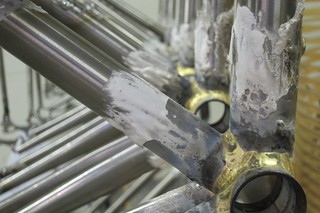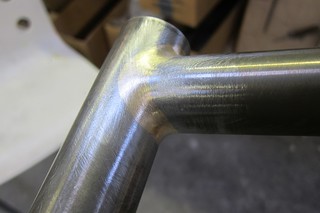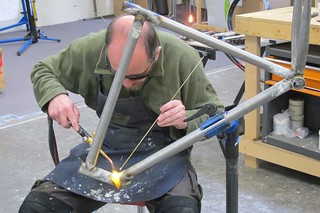Dear Guest,
Please register or login. Content don't create itself!
Thank you
-
 fillet brazing rod size
fillet brazing rod size
hi all
i was wondering what you guys find the easiest size of brass rod to use while fillet brazing ?
was trying with 1.6 rod, but it felt like i had to move fairly slow just to keep things in reasonable shape
any advice will be much appreciated
thanks
nbc
-
 Re: fillet brazing rod size
Re: fillet brazing rod size
The answer kind of depends on the size of fillet wanted, the flame size and the skill of the brazer.
Most will start out with a small flame and thin rod. Practice by doing brass columns raising off the tube's surface, chasing blobs over the surface and other heat control exerciseses that you can think of. Once you have a handle with small flames and rods then larger ones will be advantageous. Using thick walled tubes at first also helps slow down the temp highs and lows.
I use 1/16" (about 1.6mm) rods almost exclusively. Depending on the joint my torch tips are about .036-.038" orifice diameter. Once the flow/tinning on the joint has been done (usually with a stronger flame) then i go back and work the flame's inner cone up tight against the joint and with a quick flicking on and off the target zone work the temps to the amount needed to just melt off rod and meld on to the tinning. With practice you can work the shape of the deposited brass with the flame without letting it run away.
I will say that this is harder to get good at for me then other brazing. I build only during the Winter and find i have to relearn the fine heat control technique over and over each year. I have dozens of tube stubs that i have practiced on laying around. you will too. Think of it like a musician. The time you see/listen to his work is only the tip of the iceberg. The amount of practice that went into getting good is far greater then the time don't doing the act. Once a certain amount of skill is learned then it still needs to be kept up with. The pros do this by working every day at their craft. Us mortal people need to practice. Andy.
Andy Stewart
10%
-
 Re: fillet brazing rod size
Re: fillet brazing rod size
I like 3/32 the best. Flow time is great and it doesnt get mixed with the silver (doh!)
-
 Re: fillet brazing rod size
Re: fillet brazing rod size
I started practicing with 3/32 (about 2.3mm) this week. It seemed like I was getting a more uniform/smooth appearance after filing/sanding than with 1/16. With 3/32 I could use a 14mm tube as a sanding block and the fillet mated with the profile of the tube very well. With 1/16, the 14mm tube was too big to match trough of the fillet (it would smooth our the edges of the fillet but not the center). With 1/16 I could make a more uniform fillet but it took a more delicate touch to clean it up. 3/32 was uglier pre-clean up, but it cleaned up with less fuss. Also, with 3/32 you have more material on the rod so you aren't grabbing for a new rod as quick as you do with 1/16.
-
 Re: fillet brazing rod size
Re: fillet brazing rod size
3mm here for almost everything. 1.5mm for bridges.

Stoaters by shandcycles, on Flickr

Head tube junctions by shandcycles, on Flickr

Head tube junctions by shandcycles, on Flickr

Gordon's custom MTB by shandcycles, on Flickr
-
 Re: fillet brazing rod size
Re: fillet brazing rod size
I switched from 1/16" to 3/32" a few months ago, and after a short adjustment period, I really liked it. I found it easier to make uniform fillets at a faster travel speed. (Larger torch tip and more flame, too) I ran out and had to use 1/16" for a bit and I was very unhappy going back. It felt very slow brazing with it, and I it left me with more starts and stops. Fortunately, I was able to find some suitable 3/32" locally so I didn't have to suffer long.
-
 Re: fillet brazing rod size
Re: fillet brazing rod size

Originally Posted by
edoz

I switched from 1/16" to 3/32" a few months ago, and after a short adjustment period, I really liked it. I found it easier to make uniform fillets at a faster travel speed. (Larger torch tip and more flame, too) I ran out and had to use 1/16" for a bit and I was very unhappy going back. It felt very slow brazing with it, and I it left me with more starts and stops. Fortunately, I was able to find some suitable 3/32" locally so I didn't have to suffer long.
Lay two 1/16" rods on a table and tack them together in 4 spots. Now you have a thicker rod and it melts faster.
-
 Re: fillet brazing rod size
Re: fillet brazing rod size
I mostly use 1/16", but also 3/32". I have used up to 1/4"- drops a load of brass in a hurry when the temp is right.
-
 Re: fillet brazing rod size
Re: fillet brazing rod size

Originally Posted by
Eric Estlund

I mostly use 1/16", but also 3/32". I have used up to 1/4"- drops a load of brass in a hurry when the temp is right.
I use both sizes depending on how big the desired fillet is.
I have been using both a victor #1, #3 and a Smith #05
- Garro.
-
 Re: fillet brazing rod size
Re: fillet brazing rod size
update:
ended up trying some 3.2mm rod and just didn't like it, felt like i couldn't get it to melt particularly quickly,
i'm not a particularly confident fillet brazer, i like lugs really :) will try some 2.4mm rod, should give some of the advantages of a bigger rod, while still being able to melt quite quickly
NBC
-
 Re: fillet brazing rod size
Re: fillet brazing rod size

Originally Posted by
NBC

update:
ended up trying some 3.2mm rod and just didn't like it, felt like i couldn't get it to melt particularly quickly,
i'm not a particularly confident fillet brazer, i like lugs really :) will try some 2.4mm rod, should give some of the advantages of a bigger rod, while still being able to melt quite quickly
NBC
Bigger flame and better heat control?
Similar Threads
-
By Mtblucas in forum The Frame Forum@VSalon
Replies: 29
Last Post: 09-27-2013, 09:21 AM
-
By Peter E in forum The Frame Forum@VSalon
Replies: 5
Last Post: 04-27-2013, 02:51 AM
-
By Todd Mosley in forum The Path
Replies: 11
Last Post: 03-22-2013, 05:00 PM
 Posting Permissions
Posting Permissions
- You may not post new threads
- You may not post replies
- You may not post attachments
- You may not edit your posts
-
Forum Rules


 Likes:
Likes: 

 Reply With Quote
Reply With Quote






Bookmarks